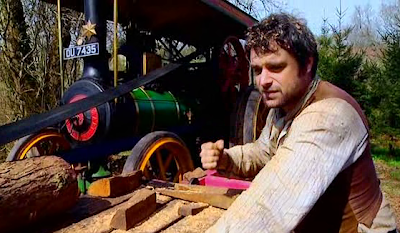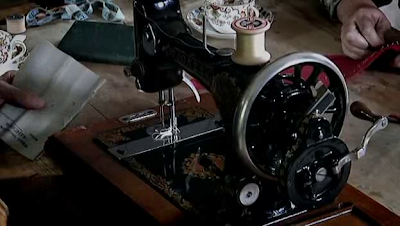Historian Ruth Goodman and archaeologists Peter Ginn and Alex Langlands are back in a new series - Edwardian Farm. This series was filmed at Morwellham Quay, a historic river port in Devon, England. It consists of twelve 60 minute episodes and shows farm life in the Edwardian Era, often highlighting how this changed from the Victorian Era.
This was an intersting time, horses were still being used for field work, but they had been replaced by water wheels for powering farm equipment and factories. Steam was still the power source of choice for trains and ships, but had either never caught on, or was already being replaced by petrol engines in other implementations.
 |
| Edwardian country estate |
The Edwardian Era was the time when there was the greatest divide between rich and poor. In Edwardian town houses and country estates it was normal to find piped hot water, wc (water closet meaning toilet), gas cookers, and motorcars. They even had electric lights long before there was a national grid, the electricity being supplied by generators usually hidden away in the basement.
 |
| Early and late Edwardian Era petrol tractors |
In the countryside people still had to deal with an older way of living, although farming became more scientific, with chemical pesticides, fungicides, and fertilizers. The biggest advance in farming was the petrol engined tractor, but this was very expensive, and few could afford it. Edwardian farmers earned less income than their Victorian counterparts, because of the importation of cheap wheat from America. As a comparison, at the end of the first episode of Victorian Farm, Ruth cooked a typical Victorian dish, leg of mutton. The typical Edwardian dish she cooks for Edwardian Farm is sheep's head stew. The Christmas episode also shows the trio having a more sombre festivity, with their main dish being beef instead of turkey.
 |
| Portable steam timber saw |
Since it was no longer profitable for British farmers to grow wheat, they grew oats as animal feed, and diversified into various other activities. We are shown Ruth, Peter, and Alex growing fruit, vegetables, and flowers (referred to as Market Gardening). Edwardian farmers were known to have one food on the land and the other in the sea and we are shown the trio fishing for crabs and lobsters with lobster pots woven from willow, foraging for shrimps and seaweed, and fish farming trout and salmon. We are also shown Peter and Alex working on board a sail trawler with a steam powered capstan to pull in the nets.
 |
| Mining - bottom left shows a compressed air drill |
Ruth takes up part time work as a domestic servant in a fantastic country estate. She also tries her hand at lace making and lace cleaning. Peter and Alex go to work in a mine, then visit an assayer who calculates the quality of the copper and tin they extracted.
 |
| Forge - water wheel and trip hammer |
In Edwardian times, village blacksmiths became state of the art forges employing many blacksmiths. Peter and Alex visit such a forge and we see that the bellows have been replaced by a water wheel driven fan, and a larger water wheel is used to drive a trip hammer (¾ ton hammer or 1¼ ton hammer which beats at 240 beats a minute).
 |
| Séance |
An Edwardian craze was spiritualisim and so Ruth takes part in séance to talk to the dead. The trio also celebrate Halloween by having dinner and playing games typical for the era.
Ruth sews Edwardian bathing suits and the trio go to the seaside on a Charabanc (bus). The beach is under a cliff, so they use a vernicular railway to get there.
The final episode is really good. They make charcoal in a clamp which is used to smelt iron ore. The iron is used to make a weather vane in the forge. The weather vane is used to forecast the weather to harvest oats with a petrol engine tractor pulling a reaper binder, while a cinematographer films the harvesting using a hand powered camera. To celebrate a successful harvest they organize a fête showcasing the latest farming equipment and inventions, including a plane.
Final Verdict ★★★★★
This is a long documentary series with 12 hours total viewing time, but it only drags slightly in a few places. Activities shown in the previous Victorian Farm series are only repeated here if there is a significant change. Edwardian Farm is quite light on traditional farming activities (since they didn't change that much from Victorian times), prefering instead to focus on other activities farmers did to diversify. I'm very pleased this series also gives a good insight into the way of living of the rich. Overall another thumbs up to Ruth, Peter and Alex!
 |
| Tea maid, boot warmer, and propeller spoon |
 |
| Edwardian Rolls Royce Silver Phantom |
 |
| Paddle Steamer |
 |
| Charabanc |
 |
| Wool mill powered by a water wheel |
 |
| Pneumatic Crane |
 |
| Peter Ginn |






No comments:
Post a Comment